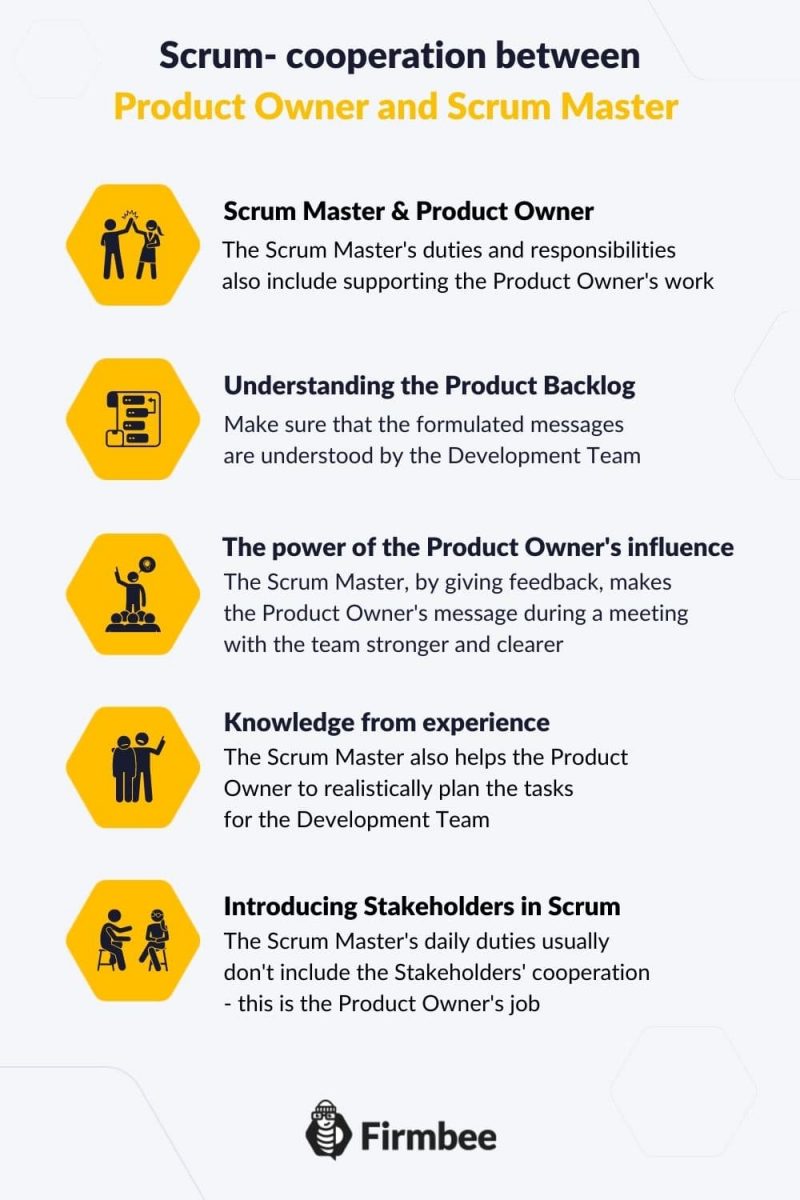In today’s article, we will cover the topic of cooperation between Product Owner and Scrum Master. The Product Owner puts a clearly defined Product Goal in front of the Development Team and requires progress in its implementation. The Scrum Master takes care of the quality of the process of its creation: a good atmosphere accompanying the Team’s work, motivation and removing obstacles. However, both the Product Owner and the Scrum Master are not two independent forces acting on the Development Team.
Cooperation between Product Owner and Scrum Master – table of contents
- Scrum Master & Product Owner
- Supporting effective communication with Developers
- Knowledge from experience
- Introducing Stakeholders in Scrum
- Summary

Scrum Master vs Product Owner
Although the way each of them works is very different, their interests converge: it is all about the Scrum Team working effectively. That’s why the relationship between Scrum Master and Product Owner, and their effective collaboration, is so important.
Most of the Product Owner’s and Scrum Master’s tasks – which we have described in more detail in separate articles – revolve around their responsibilities related to the work of the Development Team. However, the Scrum Master’s duties and responsibilities also include supporting the Product Owner’s work.
Supporting effective communication with Developers
Effective communication between the Product Owner and the Development Team requires at least two strong fundamentals: comprehensibility and sufficient impact. The Scrum Master helps the Product Owner to strengthen them.
Understanding the Product Backlog
One of the primary ways the Scrum Master helps the Product Owner is to make sure that the formulated messages are understood by the Development Team. The Scrum Master reviews the Product Backlog entries and asks additional questions to improve their clarity by paying attention primarily to:
- clarity of entries – so that Developers know exactly for what purpose they are developing a given functionality
- keeping entries concise – so that descriptions of planned functionalities include only necessary information and it takes as little time as possible to read them
In this way, the Scrum Master prevents a discrepancy from arising between the Product Goal, as the Product Owner imagines it, and how the Development Team members understood their task.
The power of the Product Owner’s influence
Scrum Master helps the Product Owner to enhance message effectiveness and charisma. The Scrum Master acts as a coach with whom the Product Owner can discuss problematic issues concerning the Product and its realization. That is why individual meetings during which discussions take place between them are so important. Thanks to these discussions the Product Owner can clarify the product vision and answer the Scrum Master’s questions before presenting it to the team.
The Scrum Master, by giving feedback, makesthe Product Owner’s message during a meeting with the team stronger and clearer. This necessary preparation helps the Product Owner communicate the Product Objective better and better during Scrum Events, which we describe in a separate article.

Knowledge from experience
The Scrum Master also helps the Product Owner to realistically plan the tasks for the Development Team. It may happen that a well-prepared Product Backlog doesn’t match the organization’s way of working in which the Product Goal is to be realized.
The Scrum Master will therefore support the Product Owner with knowledge from experience by drawing it from the observation of failures and difficulties that occurred in previous projects. Thanks to the empirical knowledge, Scrum Master can foresee the difficulties in performing the tasks and achieving the Product Goal that results from the specifics of the organization, the Team, or its specialization.
Introducing Stakeholders in Scrum
The Scrum Master daily works mainly with the Development Team. And sometimes also with the HR department, especially during the team-building process and in those rare moments when the team needs to be extended or changed. The Scrum Master’s daily duties usually don’t include the Stakeholders’ cooperation – this is the Product Owner’s job.
The exception is when you start working with Stakeholders who are not familiar with Scrum principles and roles. This is when the Scrum Masters work with the Product Owner in meetings with all the people involved in the creation of the Product. They explain who is who in the Scrum Team, which we wrote about in a separate article. They also help the Product Owner to implement good communication practices. These include, for example, the active presence of Stakeholders during Sprint Review or creating good User Stories.
Summary
The Scrum Master allows the Product Owner to focus on their work: on maximizing the business value of the product being created. The Scrum Master also helps the Product Owner in effective communication through individual coaching and discussions about the shape of the Product Backlog. What’s more, the Scrum Master supports the Product Owner with their knowledge of working with a specific Team and organization. And finally – if it is needed – facilitates the Product Owner by introducing the Stakeholders to the Scrum way of working.
If you like our content, join our busy bees community on Facebook, Twitter, LinkedIn, Instagram, YouTube.
Author: Caroline Becker
As a Project Manager, Caroline is an expert in finding new methods to design the best workflows and optimize processes. Her organizational skills and ability to work under time pressure make her the best person to turn complicated projects into reality.
Scrum Guide:
- Glossary of basic terms, roles and notions
- What is Scrum?
- Scrum values
- How to implement Scrum in your company?
- Scrum Team - what is it and how does it work?
- Who is a Product Owner?
- The most common mistakes of Product Owner
- Who is the Scrum Master?
- Characteristics of a good Scrum Master
- The most common mistakes of Scrum Master
- What statistics and metrics should the Scrum Master track?
- Cooperation between Product Owner and Scrum Master
- Development Team in Scrum
- The most common mistakes of Developers
- Scrum artifacts
- Scaling Scrum
- Sprint Backlog
- What is the Product Backlog?
- What are User Stories?
- Creating the best User Story with INVEST
- The most common User Story mistakes
- User Story Acceptance Criteria
- Estimation and Story Points in Scrum
- Planning Poker
- Team Estimation Game
- Defining Increment
- Scrum events
- What is Sprint in Scrum?
- Scrum Team Commitments - Product Goal, Sprint Goal and Definition of Completion
- What is a Burndown Chart?
- How to create and interpret a burndown chart?
- Advantages and disadvantages of the burndown chart
- Kanban boards in Scrum and Scrumban
- Velocity in Scrum - Speed of the Development Team
- Daily Scrum
- Sprint Planning
- Sprint Review
- What is a Sprint Retrospective?
- Common mistakes during a Sprint Retrospective
- Product Backlog nurturing


















